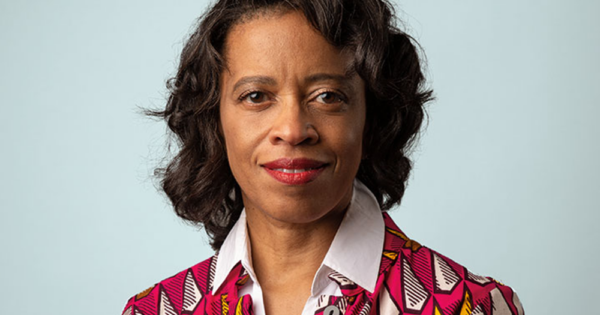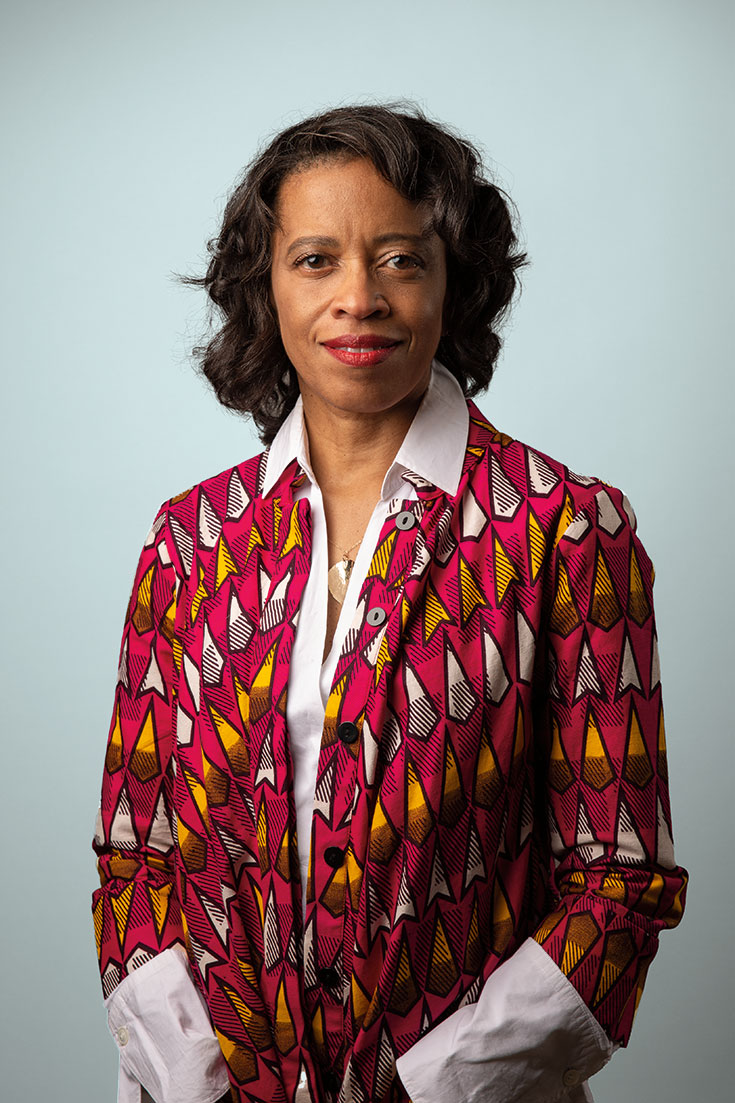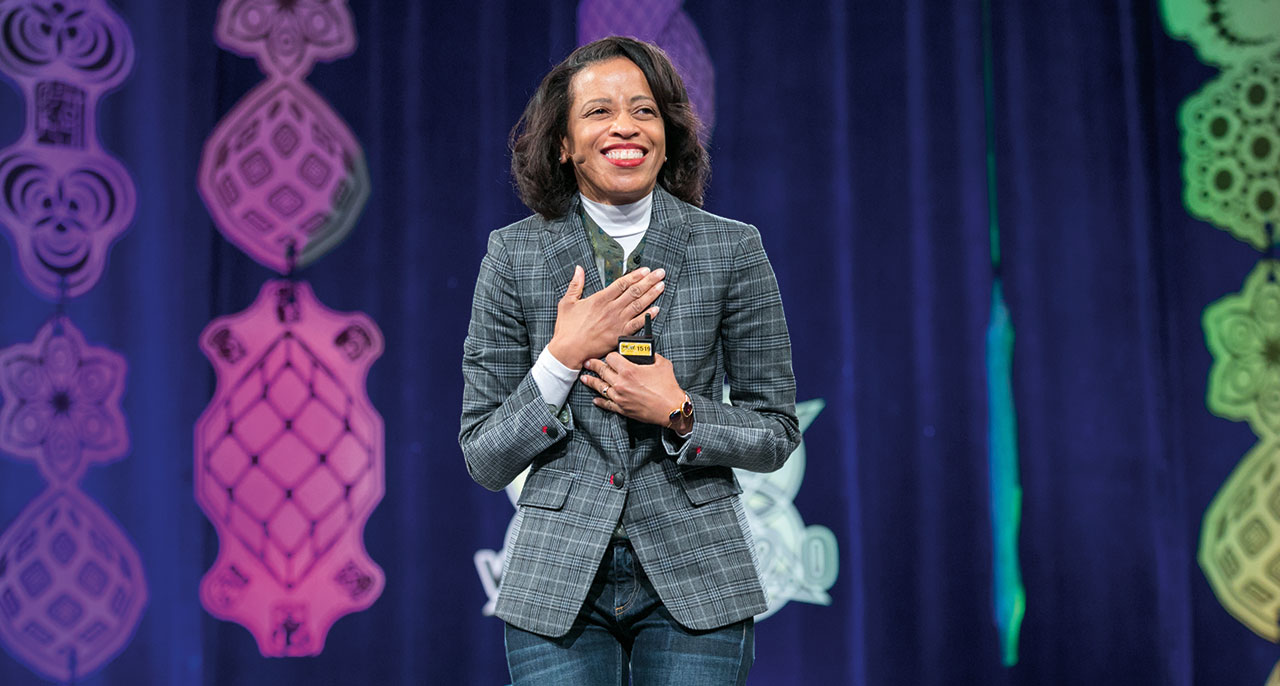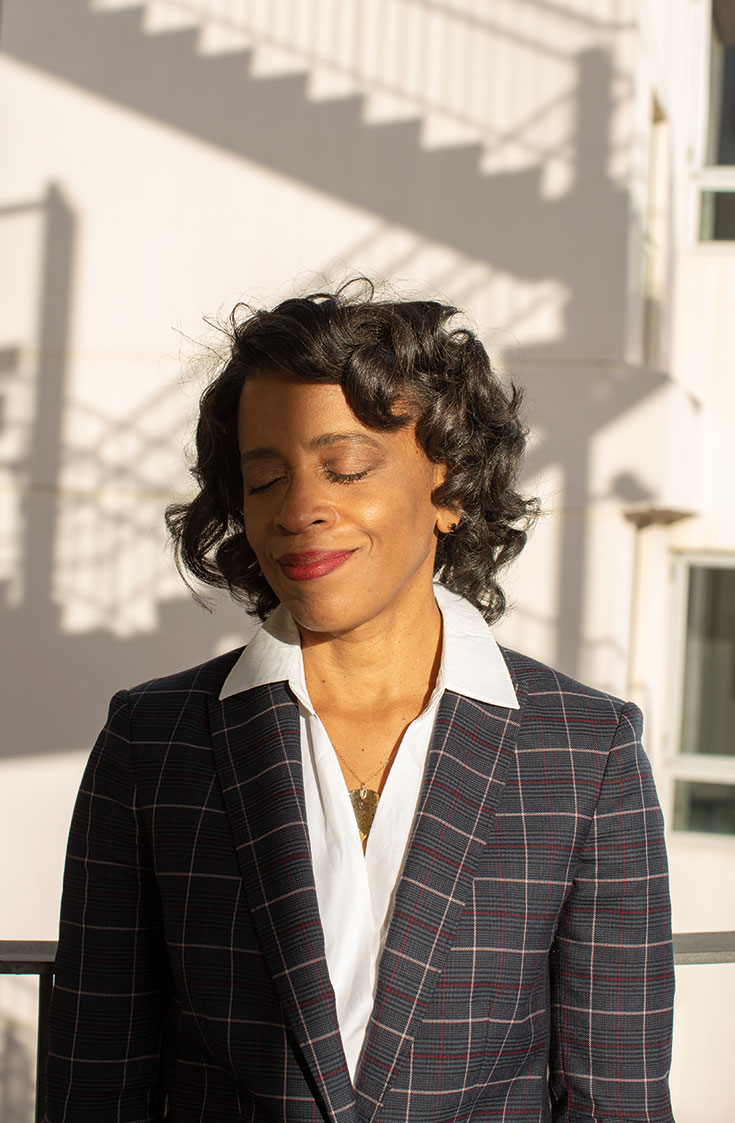Rhonda Magee: The Dharma of Racial Justice
Lindsay Kyte profiles law professor Rhonda Magee, who teaches mindfulness and other contemplative practices to help us do the inner and outer work of creating racial justice. The post Rhonda Magee: The Dharma of Racial Justice appeared first on...

Lindsay Kyte profiles law professor Rhonda Magee, who teaches mindfulness and other contemplative practices to help us do the inner and outer work of creating racial justice.

Photo by Blake Farrington
The summer that Rhonda Magee was sixteen, she got a phone call that marked a turning point in her life. Jake, her boyfriend at the time, called to tell her that his father had just kicked him out. “He did what? Why?!” Magee asked, but the truth was, she already knew the answer.
Jake’s father had never met Magee, yet she was unacceptable to him. Or rather, his ideas about her, and of people supposedly like her, were so unacceptable he was willing to cut off his own son. She was Black, Jake was white, and his father was racist. This experience of being racialized was profoundly painful to her, and it changed the direction of her life.
In her seminal book The Inner Work of Racial Justice: Healing Ourselves and Transforming Our Communities Through Mindfulness, Magee writes, “What I learned that summer inspired in me a desire truly to understand race and racism in our everyday lives and to see them for what they are: deep and pervasive cultural conditioning for grouping others into categories and placing them at enough distance to render their suffering less visible, for obscuring our intertwined destinies, and for turning us against one another rather than toward one another when we suffer in common.
“In short, what I learned that summer inspired my life’s work: dissolving the lies that racism whispers about who we really are, and doing whatever I can to reduce the terrible harm it causes us all.”
Today, Magee is a professor of law and leader in integrating mindfulness into the legal system, higher education, and social change work. Combining the inner work of personal development through meditation and other practices with the outer work of racial justice, she says, “will set us on the path toward acting with others for justice—in solidarity with those suffering the most—with humility, kindness, and the capacity to keep growing and rowing on.”
“Because there are so many rivers of pain joining and forming the ocean of racial suffering in our times, personal awareness practices are essential for racial justice work,” writes Magee. “By experiencing new ways of looking at race, we can grow in our capacity to be with one another in ways that promote healing and make real our common humanity and radical interconnectedness.”
Magee was born in 1967 in Kinston, North Carolina. It was a segregated town where tobacco farming, furniture making, and white supremacy framed life. Magee says she grew up in “the projects,” in a family dealing with trauma, poverty, alcoholism, and domestic abuse. Her mother’s second marriage moved the family to Hampton, Virginia, during a period of active efforts to desegregate the South.
“I’ve experienced some real dynamism and participated in the front line of the so-called experiment of desegregation,” Magee says. “And I’m here to say, it worked. But the thing I witnessed along the way was that not everybody in the culture was actually happy to see successful desegregation.”
The experience of living in a society that was supposed to be integrated but was, in truth, still fractured, spurred Magee on to more learning. “As I grew into adulthood, I somehow knew my worth was not measured by the gaze of white people or those who had internalized prejudices against people like me,” writes Magee in The Inner Work of Racial Justice. “I loved the Black experiences into which I had been born and all that they had given to the world—especially the many models of people struggling against injustice for ourselves and for beloved communities everywhere, all the while maintaining loving, praising hearts.”
Magee says she also knew in her own heart that more connection and love between different identity groups was something that could happen. “Having come up through desegregation and witnessed its efficacy and effectiveness, I knew what was possible,” she says. “I wanted to live my own life as a testimony to that.”
What Magee wanted most was to make a difference in society. She was on a PhD track in sociology at the University of Virginia, but when a professor suggested law was a better way to create change, she switched to the university’s famed law school. Yet when she started her career as a practicing lawyer it still didn’t feel like a true fit with her values. “It was mostly in the service or pro bono part of my practice that I was able to address some of my interests in social justice,” says Magee. This just wasn’t enough—she wanted social justice to be her focus.
As she searched for her life’s work, Magee also found a spiritual calling. Having grown up with a Christianity grounded in love for your neighbor and community, Magee started reading about other spiritual paths, including Buddhism. She began practicing mindfulness in fits and starts. She discovered in it moments of clarity and calm, but had mixed feelings about committing fully, as no one she encountered in this sphere looked like her or came from a similar background.
She finally found her spiritual footing when she was invited to join a group of lawyers in the Bay Area who regularly meditated under the guidance of Zen teacher Norman Fischer. Magee says this practice community of legal colleagues helped her settle into a regular meditation practice. “I saw that if I was going to continue to walk the path I’d begun,” she says, “building bridges between communities traditionally seen as different, I would have to find a way to deal with regular indignities without going crazy or suffering further damage to myself and others.”

Magee at the Wisdom 2.0 conference. “My life’s work,” she writes in her seminal book ‘The Inner Work of Racial Justice,’ is “dissolving the lies that racism whispers about who we really are, and doing whatever I can to reduce the terrible harm it causes us all.” Photo courtesy of Wisdom 2.0
Magee decided to further her explorations into Buddhism and mindfulness, which she saw as ways to navigate being open to vulnerability. After four years as a practicing lawyer, she then embarked on a teaching career as a law professor at the University of San Francisco. Shortly after, she met Jon Kabat-Zinn and discovered his Mindfulness-Based Stress Reduction course. “Hearing in him a language that I knew would work in law,” Magee writes, “I deepened my commitment to bringing mindfulness more fully into every aspect of my life.”
Though Magee doesn’t label herself a Buddhist, she has studied extensively with Roshi Joan Halifax. She trained as a mindfulness teacher through the Oasis Teacher Training Institute of the University of Massachusetts Center for Mindfulness, and now teaches mindfulness-based interventions, awareness, and compassion practices from a range of traditions.
Magee says her study and practice of mindfulness and Buddhism have become intertwined with her work teaching law students about race and racism. “Grounding and practice are the foundation for everything,” she says. “What we are calling here mindfulness—but really the broader term is the dharma—means centering our inquiries in an invitation to see for ourselves, to see from our own experience, to be practicing and noticing and learning. Letting that be our teacher.”
Magee has brought many different fields of thought and investigation into the work she does today. As her bio describes her, “Magee draws on law and legal history to weave storytelling, poetry, analysis, and practices into inspiration for changing how we think, act, and live better together in a rapidly changing world.”
“I think what I do,” she says, “is help cultivate spaces for deepening our ability to navigate our social differences—whether they be about race or other kinds of identities—and create spaces where we can deepen our ability to navigate different and diverse settings with more of a sense of restoration and joy coming out through the process itself. I rely on mindfulness and compassion practices to support people in doing that.”
Magee’s message is that we can’t shy away from talking about racial justice in a world polarized by race and racism. She acknowledges that such discussions, even among people we know and love, can be fraught with the potential for conflict and confusion. We need help navigating these challenges, she says, with ways to be there for ourselves and others and to encourage new connections and an opening of minds and hearts.
That’s why Magee teaches a practice she calls ColorInsight. She describes it as work that “supports you in looking at race and racism as perhaps you have never done before, whatever your background or experience. It supports you in rejecting the temptation to normalize racism, or to bypass it. Instead, it helps you find ways to stay in the complex struggle for multiracial, democratic justice—in courageous fellowship with others.”
“While we all need support in doing the work of racial justice,” she writes, “the specifics of that work will differ for each of us. The very nature of race—a concept, an idea created to implement and justify the hierarchy resulting from white supremacy—is that its impact can differ dramatically from one person’s life to the next.”
We often refer to people as white, Black, or some other race, without thinking twice about it, as if the reality of race were part of the natural order of things, some scientific or biological fact. It is not.
Magee defines racial labelling as “a complex of behavior and explanatory stories that enable some human beings to assert power over other human beings. Though it can seem natural or simply biological, it is not. Racism depends on the social construction of what sociologists have come to refer to as ‘racialized’ bodies, which is to say, the idea and practice of people being assigned racial labels that, as we have been trained to understand, sit in a relative hierarchy of worth in relationship to other racial labels.”
The work of racial justice, says Magee, is “learning about something that you thought you already knew. You will be challenged to really examine your beliefs, conditionings, and behavior. It may take a while to get comfortable thinking and talking about race in new ways, to feel a sense of what multicultural educator Robin DiAngelo calls ‘racial literacy.’ And racial literacy requires emotional awareness.”
In The Inner Work of Racial Justice, Magee divides the work into five sections that build on each other: grounding, seeing, being, doing, and liberating.
Grounding, she says, involves pausing, sitting with compassionate racial awareness, and honoring your true inheritance. “Your true identity, who you really are, may have little to do with the way that race attaches to you in the world,” she writes. “And your cultural inheritance is as a member of the human family with particular ties to a part of the world.”
Magee’s concept of seeing means first recognizing what actually is and then seeing it more clearly. “So much of dharma practice is about recognizing what’s there,” Magee says. “It’s about seeing what we haven’t seen before and opening up the aperture so we’re not missing different aspects of our reality.
“So we sit, noticing the perceptual lenses that shape the things we see easily, the things we cannot see, and the things we are resisting. From this we move to really being investigators—recognizing and accepting that there is race and racism in my life, in my community, and in me.”
After seeing, Magee encourages being with the fact that race and racism exist. “It’s like saying we want to transcend the notion of the breath,” she says. “We could say, ‘Breath is just an idea.’ And yet we have to breathe to live. Race is just an idea. Yet it’s in our culture. We have to relate to it. Choosing how to be in relationship with it becomes an ethical imperative.”
Some of what we will encounter doing this work will be unpleasant, Magee acknowledges. “Painful, perhaps even suppressed memories may come rushing into your mind, including reactions tied to unhealed wounds as they rise to the surface,” she writes. “As a Black woman, I realize that this work is often particularly painful for me and other people who have suffered from racism and identity-based bias.”
Magee says that people who have been racialized may feel uneasy or even angry when engaging in this work. “It may be because we are openly acknowledging—perhaps for the first time—that the pain of racism falls disproportionately on us, or it may be due to the common experience of having to deal with these issues in ways that seem designed to serve the interests of culturally dominant whites instead of ourselves.”
For those who identify as white, Magee encourages the practice of courageous self-examination. “As a culture, we must be prepared for a long and courageous look at the nuances of whiteness. Fortunately, more and more of us are doing just that, with whiteness-sensitive racial justice organizations showing up across the country,” she writes. “But this work must not be episodic. This. Must. Be. Ongoing. Because our unwillingness to look at the majority experience, at whiteness in particular, and to reflect in a fulsome way on the experience and functions of white identity, is a big part of what we are up against.
“But if we have the courage to examine whiteness, to see it more clearly, we might be able to ask and answer better questions together. We just might be able to see how actually to do the work, together, of redeeming the history of white supremacy, of acknowledging it, actively rejecting it, and deconstructing it where it remains as a part of our culture. We might be able to envision a new story of America.”
Next is doing. This is the intense work of engaging in discussions about race, utilizing deep listening and taking risks to speak about race and other forms of social identity bias. Magee acknowledges that such interactions can be challenging, but are possible with the tools learned through nonviolent, mindful, and awareness-based communication practices.

“As we look deeply into racism with mindfulness,” Magee says, “we need to meet whatever arises—including our own and others’ emotions—with an uncommon level of kindness and love, and with a genuine wish for healing.” Photo by Blake Farrington
In the section on “doing” in her book is a chapter entitled “Fuck! And Other Mindful Communications.” In it, Magee tells the story of a student who learned about a massacre of Indigenous people he had never heard about before. “Fuck! I just can’t believe this happened,” he shouted. “And at the same time, I can’t believe I didn’t know about this! How much must I not know about racism in our history?”
Magee says this shows why creating space for strong emotion is necessary for developing deeper understanding of how race operates in our lives. “Being able to feel all of our feelings, and being able to name them without shame or disapproval, are crucial steps along the path,” she writes. “Only from there might we realistically be able to take actions that more effectively transform the dynamics by which racism is perpetuated in our lives.”
Many people experience trauma, exhaustion, despair, and grief caused by racial injustice. “There’s a lot to heal from right now,” Magee says. So her last step, liberating, examines what is required to heal from the traumas of our own racialized experiences.
“When you look beneath racial injuries, you may notice that they are no more permanent than the moments, spaces, or bodies in which they occur,” she writes. “The pain we feel is increased by our defensiveness and our difficulty letting be.
“As you work with these wounds over time, you may find that you can hold these experiences in a way that promotes healing and feeling better about life, despite the ever-present possibility that a microaggression may occur.”
The key to all of this work, says Magee, is love. “As we set out to look deeply into racism with mindfulness, we need to maintain a commitment to meet whatever arises—including our own and others’ emotions—with an uncommon level of kindness and love, and with a genuine wish for healing. We need to develop and embody radical compassion and the will to be a space within which racial truth can be spoken and heard.”
Magee highlights the importance of compassion—the desire to act to alleviate the suffering of others—in the work of racial justice. You can feel her own compassion in her aspiration for all those doing the work for racial justice:
“May we bring ourselves into continual conversation with one another and with the racial injustices here and now, ending the suffering and making things right—one moment, one risk, one luminous reconnection at a time.”

 BigThink
BigThink 






























